Artists
Hollywood Icon Sharon Stone on Her Most Challenging Role Yet: An Abstract Painter
The multi-hyphenate star took us on a tour of her new exhibition and sat down for a sprawling, enlightening conversation.
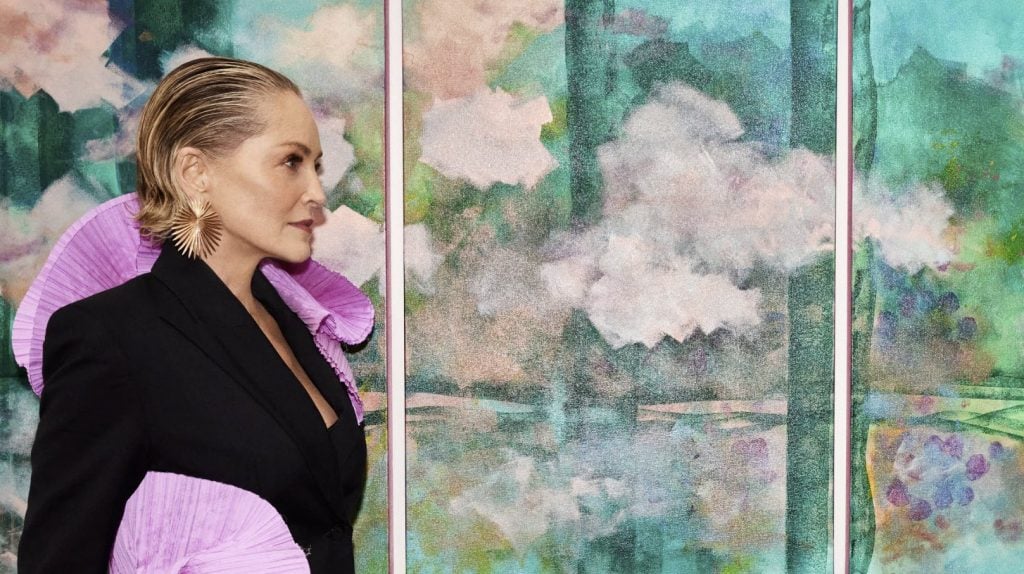
The multi-hyphenate star took us on a tour of her new exhibition and sat down for a sprawling, enlightening conversation.

Whitney Mallett

Sharon Stone’s rebirth as an abstract painter has already earned her a better reception than most who attempt the actor-to-artist transition. A big reason why she’s being taken seriously as an artist is because she takes her art seriously. It’s palpable that she’s committed to challenging herself in the exhibition, “Welcome to My Garden,” now on view at C. Parker Gallery in Greenwich, Connecticut.
Compared to the paintings she showed earlier this year in her first solo exhibition in Los Angeles, the 19 new works in this East Coast show suggest a more developed language with greater depth and discipline. Still the strength of the work might not be the only explanation for why Stone, 65, is being treated so fairly. Jerry Saltz’s cosign certainly hasn’t hurt—the Pulitzer Prize-winning critic (and ham) has done two public convos with Stone, one on each coast. But Stone’s work is also debuting at a moment when the market is hot for women abstract painters—Jacqueline Humphries and Lucy Bull being two examples of artists riding the cresting wave.
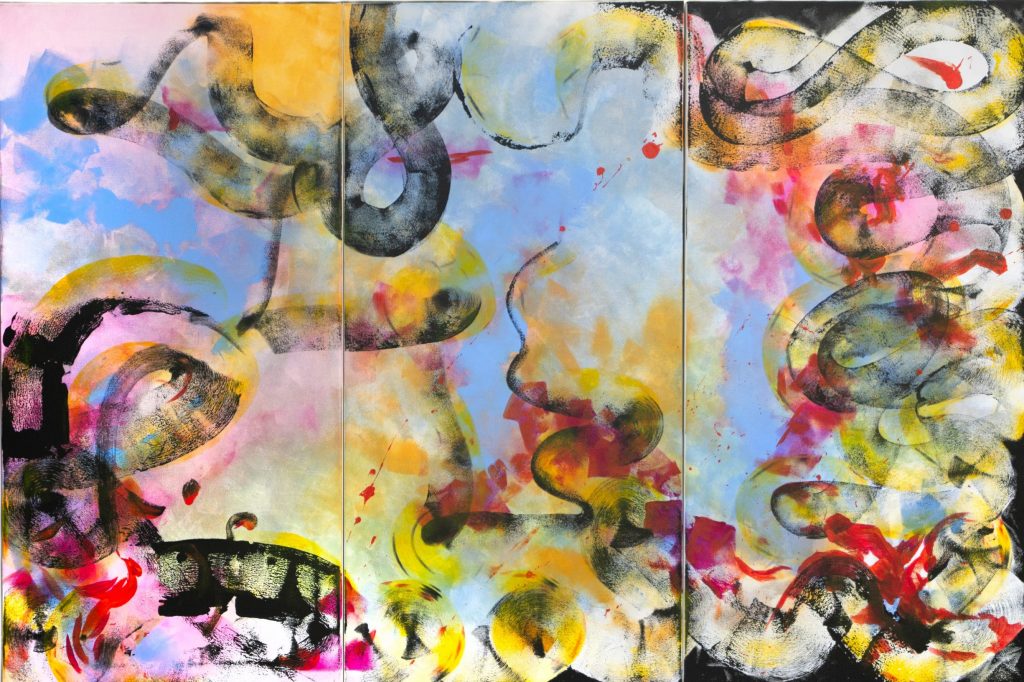
Sharon Stone, A State of Affairs (2023). Courtesy of the artist and C. Parker Gallery.
At the same time, pop culture is currently reappraising its ’80s and ’90s sex symbols, with figures like Sylvester Stallone, Arnold Schwarzenegger, and Pamela Anderson all being acknowledged for their intelligence and agency. While Stone was never considered a bimbo—her femme fatale roles always lending her a coolly intellectual appeal—she still suffered from the era’s misogyny and erotic sensationalism. And like her peers, she’s benefitting from this climate’s revisionist redemption arc.
Today, Stone is being honored by the United Nations as their Global Citizen of The Year. The award is being presented by the U.N. Secretary-General António Guterres. I caught up with her yesterday at her gallery in Greenwich to learn more about how painting fits into her story. She wore jeans and bare nails, her slicked back hair streaked with grey, and toured me around the colorful works on the walls before delving into her singular journey.
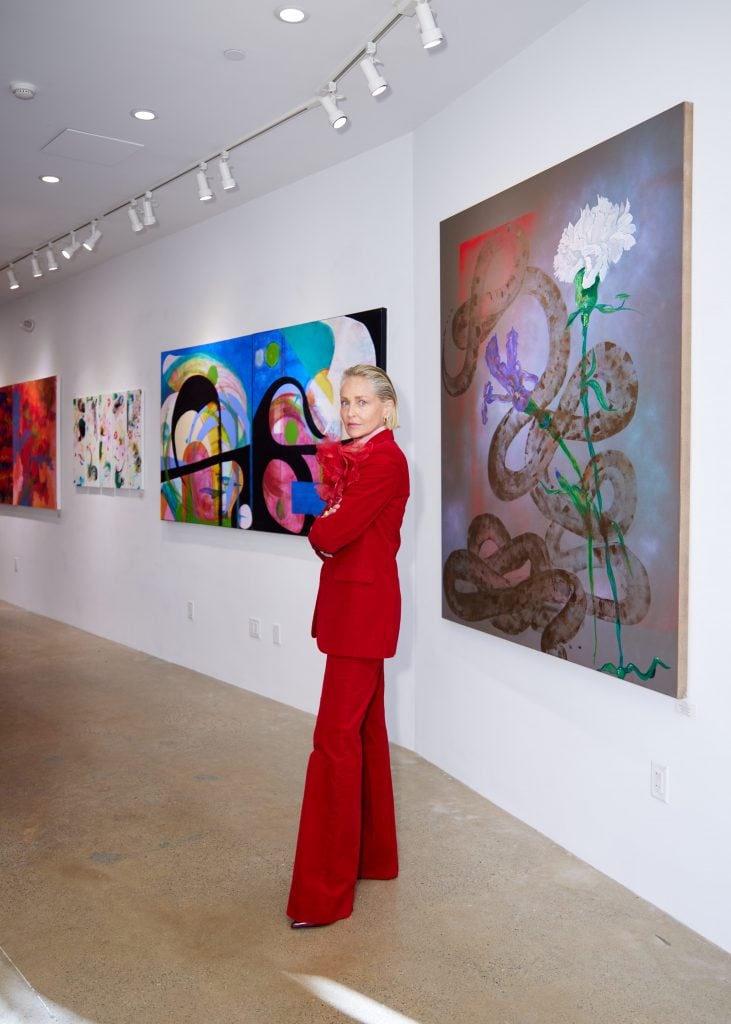
Sharon Stone at the opening of “Welcome to My Garden” at C. Parker Gallery. Photo courtesy of C. Parker Gallery.
I have to admit, I rewatched Basic Instinct this morning and was like, “I’m interrogating, the subject of the most famous interrogation scene ever.”
You know, that scene is not anything that anybody made it out to be.
Totally, but there was this line connecting experimentation and pleasure. I thought that was a nice sentiment to frame our talk about painting. You’ve used a paint roller in many of these, right?
I used it on the clouds here. I love paint rollers, of all sizes. I use them a lot. I use everything—rollers, house-painting brushes, sponges, tissue paper. Everything. I don’t use stencils.
Are you familiar with the artist Michael Krebber?
No.
You should check him out. That was the first reference I thought of seeing your work. He’s well-known for using the small paint roller. He taught for a while at Städelschule and he shows in New York with Greene Naftali.
[Looks up Michael Krebber’s paintings on her phone.] Oh beautiful. That’s fantastic. So gorgeous. Well, that’s a compliment. Thank you. Where did you say he taught?
Städelschule. It’s a really good art school in Germany.
I love the Germans. I love Bauhaus.
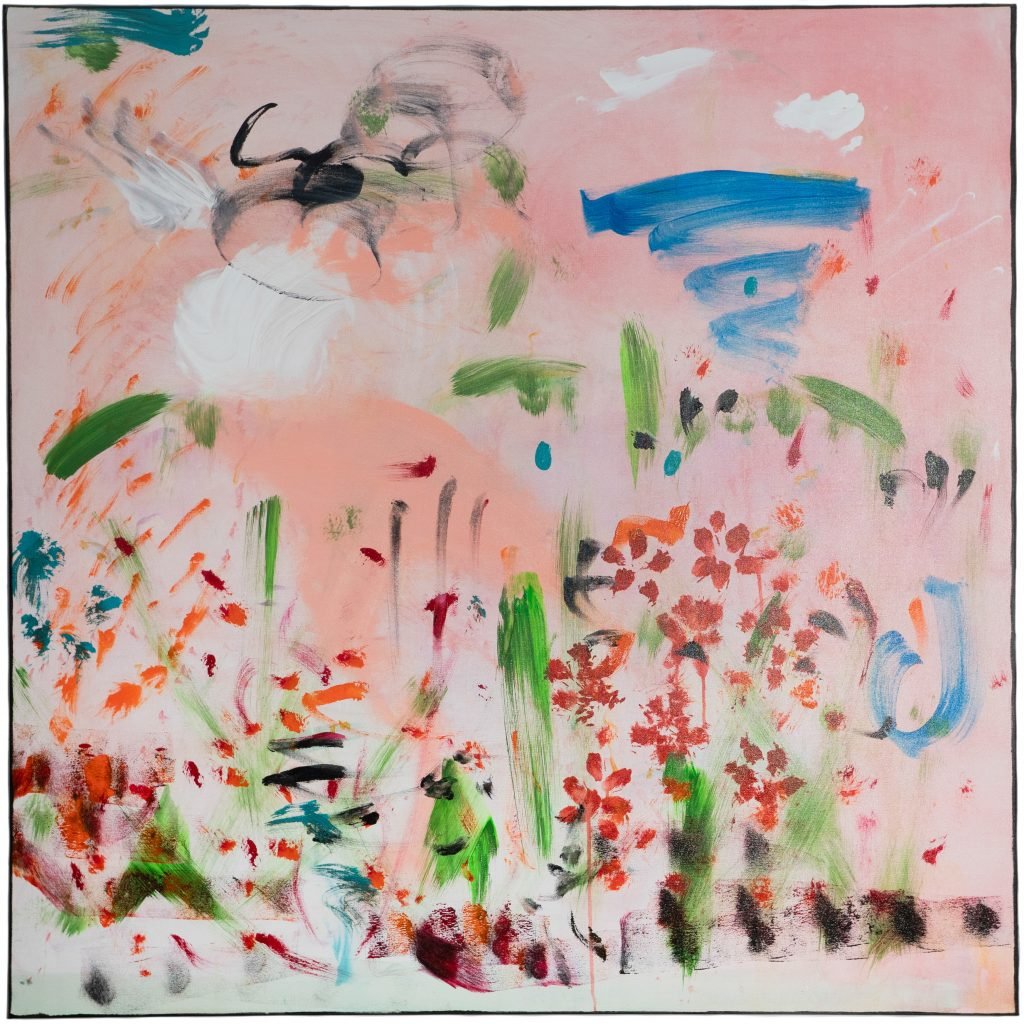
Sharon Stone, It’s My Garden, Asshole (2023). Courtesy of the artist and C. Parker Gallery.
Tell me about this one.
My girlfriend was trying to have a baby in her 40s and she lost one, like, four or five months in, and then she finally succeeded—the most beautiful, cutest little girl. She had it like a normal person. She gained more than five pounds and wasn’t wearing a swimsuit two weeks after. When her in-laws came to meet the baby, her father-in-law told her she couldn’t eat the pizza because she was too fat. When she told me what happened, I just started crying. In that moment, it was men telling us what we’re supposed to do with our bodies and it was the drones flying over my backyard, I just lost it. Like cartoon tears. I was so mad and so upset and so hurt, all at the same time. People who don’t understand something shouldn’t try to be the boss of it. It’s a devastating misconception and abuse of power. That’s what this painting is about.
This painting relates to the title of the show, “Welcome to My Garden.” Do you garden?
I am not the greatest gardener. I can’t keep indoor plants alive. But I’m pretty good with outdoor plants now. We have such bad drought situations. Now, we have this really erratic tropical rain. Like, tons and tons of rain and then no rain. We’re getting bugs that we never had before. We’re getting mosquitoes now. So, I hardscaped everything to save water.
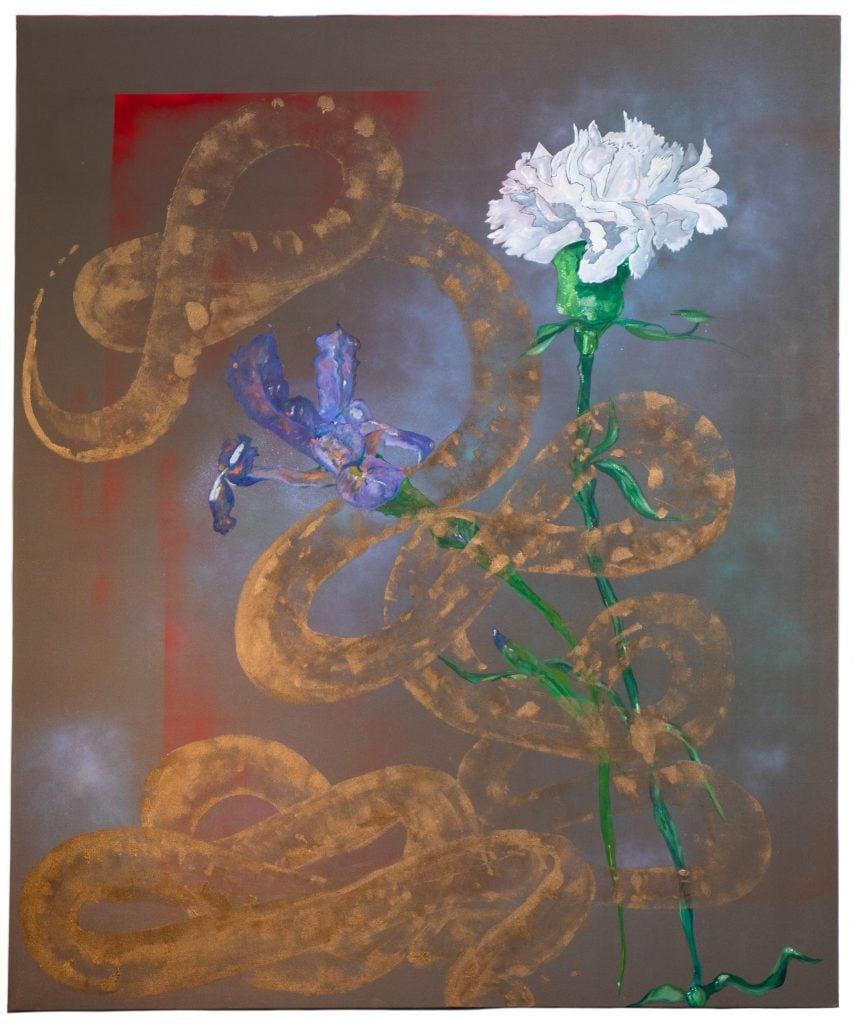
Sharon Stone, Welcome to My Garden (2023). Courtesy of the artist and C. Parker Gallery.
Hardscape?
It’s where you put concrete down, so you’re not growing plants and wasting water. And then I started doing potted plants and I planted fruit trees and vegetables—valuable stuff. It’s all doing pretty well. But I’m learning, you know, because I want to do it thoughtfully. Not just flowers. I want to put in enough plants to bring the birds and the bees and the butterflies. I’m learning because I grew up in the country.
I read you were breaking in horses growing up.
Yeah, it was the country, and we grew all of our own fruits and vegetables. But in Pennsylvania, it’s a more normal seasonal environment. Nature takes care of itself. And at that time, we hadn’t destroyed nature as much. It’s more complicated now to be good at it. Every single thing that we do is basically coming from nature. It starts with nature and ends with nature.
Do you think your practice as an actor has helped you be in the present?
Well, sure. When you’re acting, you have to allow yourself to be expansive enough to accept these other valances. You can’t do that unless you’re willing to wrap them around your own personhood and let the power of your own internal engine drive this other personhood. To accept being a completely other person is a big acceptance of knowingness—knowing another person, and then letting them take over your being. You can’t do that unless you’re willing to really hear, listen, see, imagine, know.
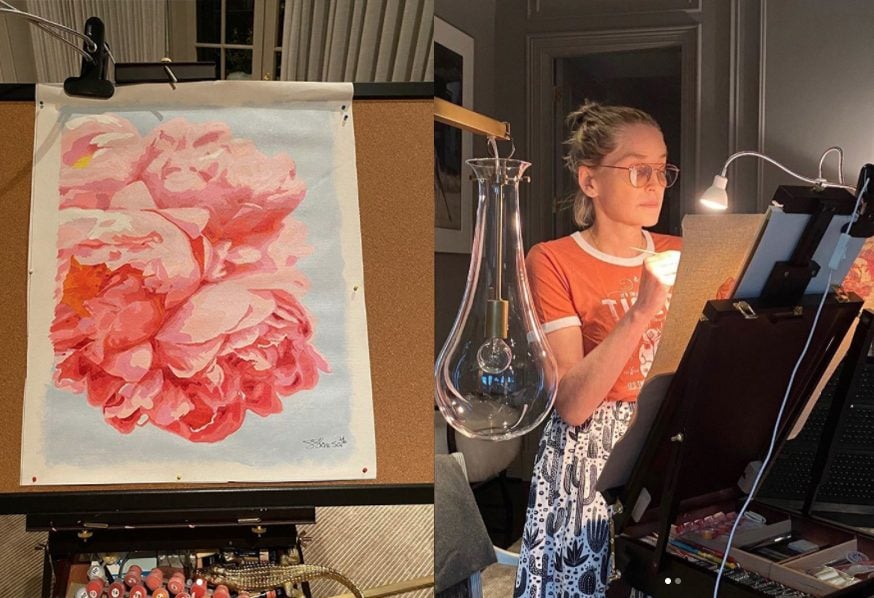
Sharon Stone is now a painter. Courtesy of Sharon Stone.
When did you start painting?
When I was a little kid. My aunt had double masters in painting and English, and she taught me to paint. Painting was just another language I grew up knowing, like if you grow up in a musical family. I grew up in an environment where painting was just happening. I spent every minute I was off from school with my aunt and my grandmother.
Was that because your parents were working all the time?
My dad was working. I was my aunt and grandmother’s favorite, so they stole me away every chance. They were a little bit more well-to-do and quite eccentric. My grandmother had all these eccentric friends. They all liked to have cocktails. They would come over and get lit up in the kitchen and carry on. My grandma and my aunt, they were just hilarious, and great friends. They even went on double dates together.
So, they’re the ones who got you into the arts, and you received a creative writing scholarship when you were very young.
I was 15 when I went to college.
Do you see your writing, acting, and painting as coming from one creative source?
I do. But then in L.A., of course, they didn’t. You know how it is. They want women to stay in our lane, lest we lap them.
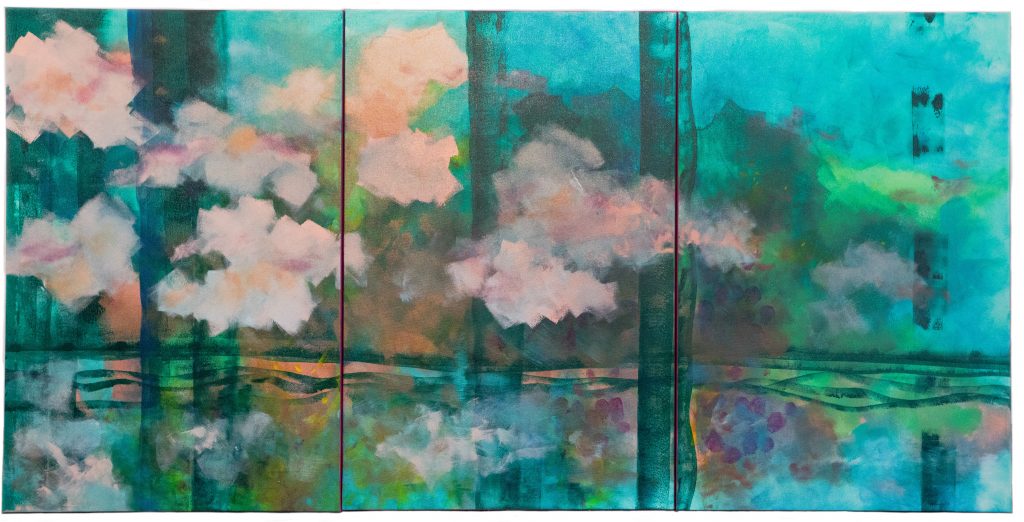
Sharon Stone, Reflections (2023). Courtesy of the artist and C. Parker Gallery.
Exactly. So you went to college very young on this creative writing scholarship, but then you ended up leaving early to become a model?
Yes. Because my brother was in trouble. He went to Attica. I was 19 when I went to Italy on my own. It was intense because it was the late ’70s. It was a very wild time to be a kid on your own in New York, Italy, Paris, and Germany—the whole Studio 54 period. Fortunately for me, because my brother was already that guy, I was no longer interested. I was the person who would go to Studio 54 and just drink Cokes and dance all night. It was really a fun time, but it was very crazy. There were a lot of dangerous things that happened. I was able to navigate through the majority of them. Still, certainly a number of awful things happened, and a number of young girls that I worked with died. There were no guardrails at all. Really young girls were wildling in those days without supervision.
And then you ended up in L.A.
I’d been living in Paris and modeling in Germany quite a bit. I used to throw the Deutsche Marks in my cabinet and let the maids take them because I figured they needed them. I still don’t care about things that much, which seems weird because I have so many things. I have a beautiful house, but I’m not a thing person. The maids took unbelievable care of me, like I was their kid. I lived in the artist’s loft of a hotel. You’d take the elevator to the top, and then there was this little staircase up to my room, which had the slanted walls, like an attic ceiling, and a lovely little terrace. It was a beautiful period of my life. I used to go with my girlfriends to these big cabaret shows and then we’d go out with the performers to their clubs out in the countryside afterwards and stay out all night. After I came back to New York and stood in line for a Woody Allen movie, I got the part. When I got offered other movies, I moved to L.A.
I just watched The Specialist. I’m obsessed with ’90s thrillers.
Everybody loves erotic thrillers and they don’t make them anymore! Why? It’s such a sweet spot. They’re like $40- or $50-million pictures. They’re not these tentpole $150-million pictures. You can make your money back because everybody wants to go. It’s the kind of movie people want to see because you can get laid.
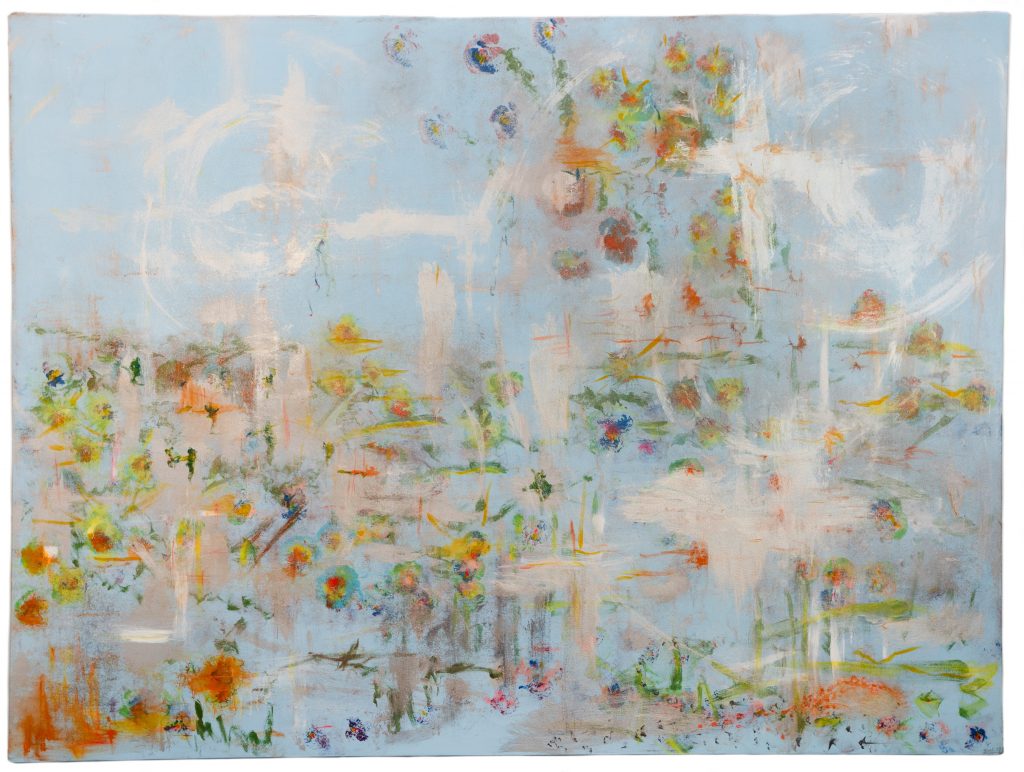
Sharon Stone, Giverny (2023). From the collection of Sue and Michael Bodson.
The other day I thought I watched a contemporary erotic thriller Emily the Criminal with Aubrey Plaza.
I love her. She’s my friend.
But something about it was more mumblecore than noir.
It’s because they want to be too politically correct. They can’t let one of the characters just be fucking nuts.
Yeah, the younger generation does seem to think that bad behavior in a movie or any fiction is endorsing bad behavior. You can’t have a villain who’s just like—
A villain! I always felt when I played a villain, you can’t sugarcoat a villain. And a villain has charisma. That’s what makes them a good villain. That’s how they get away with all their shit. They say just because the devil came to the party, it doesn’t mean you should offer them a seat. Well, they’re a good party guest!
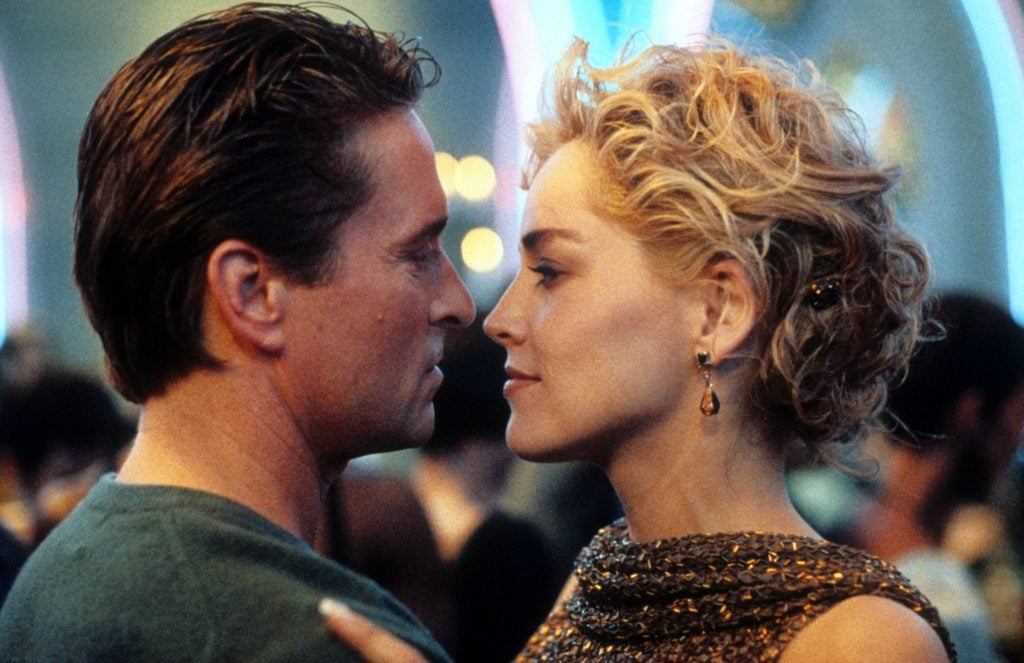
Michael Douglas and Sharon Stone in Basic Instinct (1992). Photo: TriStar/Getty Images.
It’s a boring party if no one there is toxic.
It’s a key element that they miss now. They don’t know how to make a villain villainous. I think people don’t want to play the villain, and I understand that because it’s a mindfuck. You don’t go home feeling great at the end of the day.
I walked in my sleep while I was playing that character in Basic Instinct. I woke up in my car twice. It really messes with your brain because it’s not your natural state. I don’t think villainous people can play villains. I think you have to be a good person to play a villain. It’s hard work, and it’s a hard place to live. It is your shadow self. And you have to dig in and be really willing to expose it. It’s brutal.
To have emotional depth as an artist, you can’t be avoidant.
That’s where a lot of the juice is. You can’t be afraid. Walter Mosley, the writer—I took his masterclass online because I think he’s exceptional—he really says you cannot pull your punches. You have to say the thing, and if people hate you later, tough. You have to say the stuff. When I wrote my book, I really looked to him for guidance.
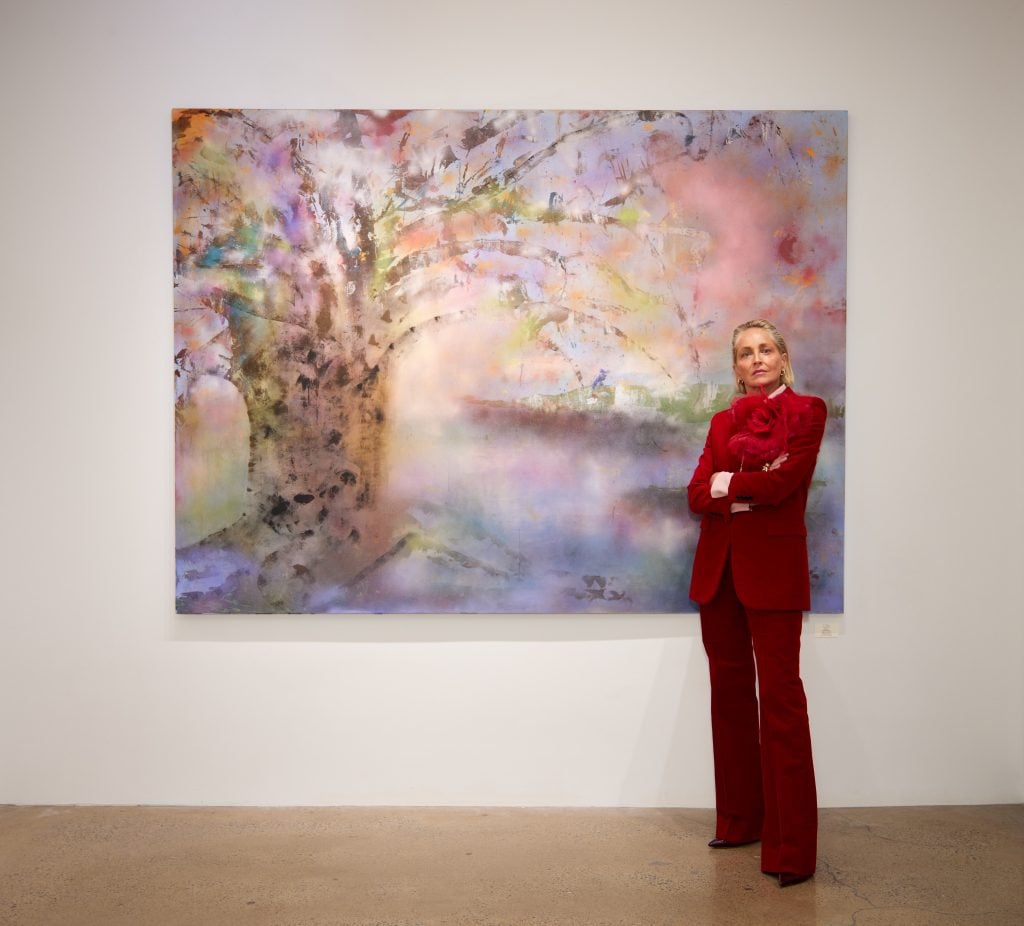
Sharon Stone at the opening of “Welcome to My Garden” at C. Parker Gallery. Photo courtesy of C. Parker Gallery.
I was curious about the relationship between your memoir The Beauty of Living Twice and these paintings. Did writing your story open you up?
It really did. The paintings came after the book, and I think that it really helped. But I’m writing another book now, too. It’s fiction. It goes through the ’70s till now. It’s a complicated story, but it’s something I really wanted to try to understand. I feel like it’s good to write your own stuff because that’s where you really get to the profundity of your honesty. When you’re writing fiction, it’s easier to fake your honesty. So, once you’ve written about yourself, then you have greater clarity about your own honesty. Because even in fiction, there’s an honest place. You have to tell that really baseline truth all the time.
When I did tell the truth in my book, there were people in my family who went around telling people, “She lied.” Because they didn’t want to face their own truth, they couldn’t deal with me telling my truth. When you’ve been willing to live in a prescribed reality that keeps the lid on things for everybody, when you tell your truth, the rupture that it creates, it blows the lid for everybody.
The atmosphere in the room has changed.
And their ability to manipulate you is over. Because once you’ve decided to put two feet in the concrete of the truth, you become immobile. You become immune to their manipulation. But I highly recommend it. Clearing your plate is unreal. You think the whole house is gonna fall over. You think a tornado is gonna wipe out your town. And it’s like two books fall off the shelf. That’s it.
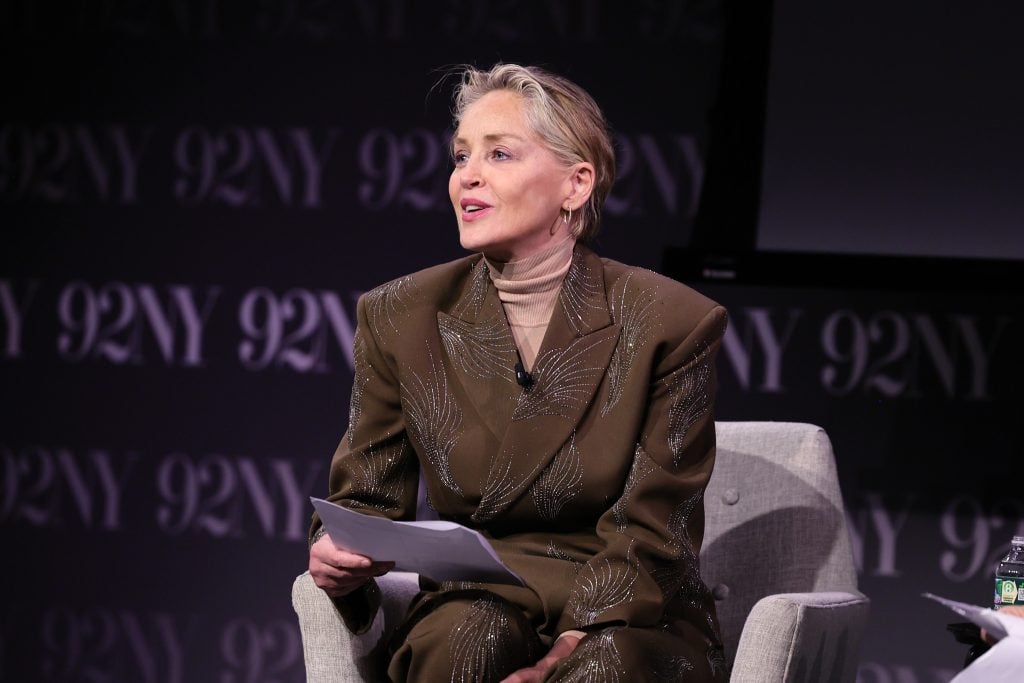
Sharon Stone attends Sharon Stone And Jerry Saltz Talk About Art at 92NY, New York on December 14, 2023 in New York City. Photo: Theo Wargo/Getty Images.
In the talk you did with Jerry Saltz, you said there’s freedom in discipline. Freedom comes from discipline.
I believe so. For me, that’s really the Jane Fonda of it all. Her discipline, when it comes to fitness, her work, climate change, really anything she ever gets involved in—she’s always been such an example to me. The truth is you get to choose what you do with your life. You get to choose to stand up for things. Look at all these paintings I made. They’re about visiting China, thinking about Amelia Earhart, politicians being crazy, women being oppressed, valuing nature. Artists get to express themselves. What a beautiful thing to get to do.
What do you think about the relationship between art and wellness?
They go hand-in-hand. In America, the arts are our second largest taxable export. But then why are they taking art programs out of schools when it’s so valuable to us? It’s valuable in so many ways. It stops recidivism in prison.
I met an artist last night, and she’s talking to some of the big galleries, but they want her to be 85, and she’s only 70. She said it’s like the Hunger Games for artists in New York City: everyone competing for a few slots in this system that supports only one artist getting to be the star.
Only one woman, but there can be about 10 men. It’s new that women are coming into the scene now, but half the women they’re letting in are dead.
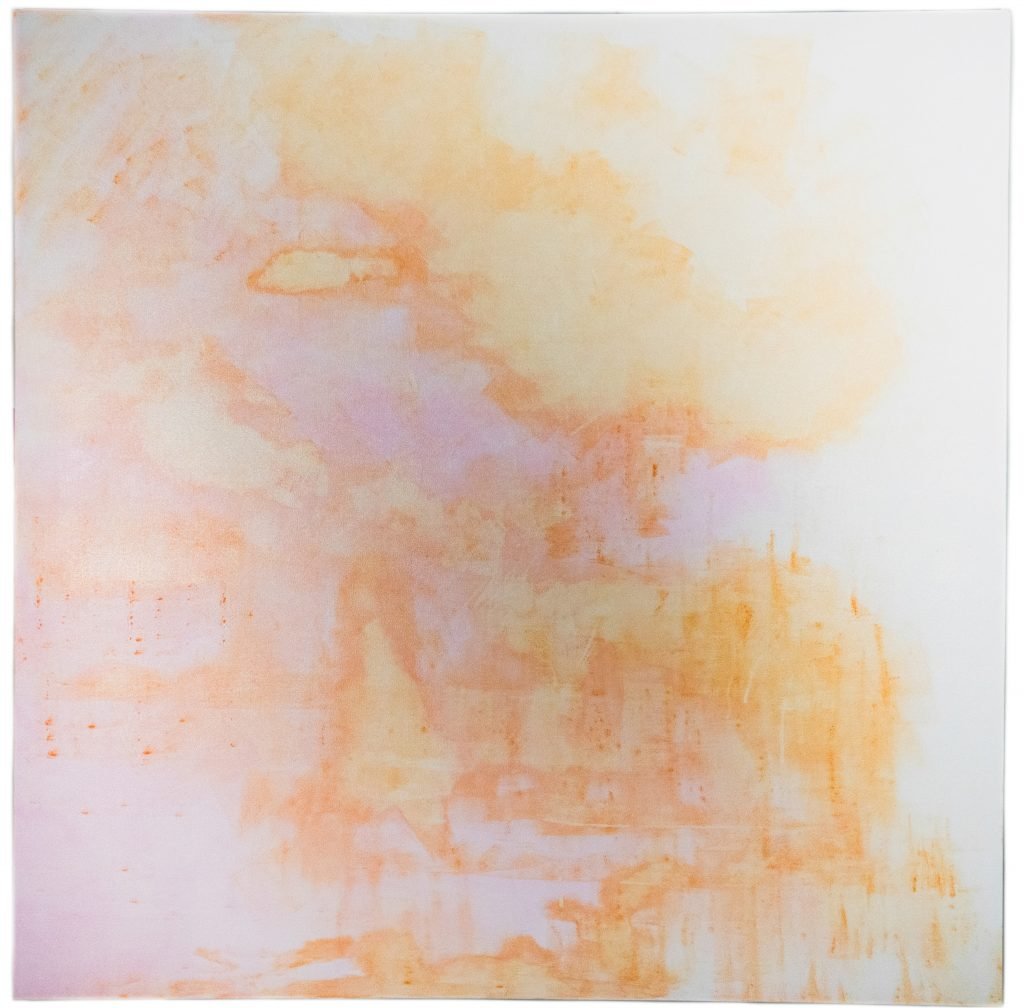
Sharon Stone, Dreamscape 1 (2023). Courtesy of the artist and C. Parker Gallery.
Because then they get control of their estates.
Suddenly, now we’re looking at Elaine De Kooning’s art! It’s just brutal to look at when women get to show their art. I feel so blessed that I’m getting to show my art now. It’s starting to happen. Jerry [Saltz] has been so kind to me. I think it’s because he believes in women being able to show work. It takes so much for women to get off the ground. People promise things and then nothing happens. I’ve had it happen with galleries, and it was like that for me in the beginning before. I’d get hired for a movie, and then two weeks later, I’d read in the trades that they’d hired someone else.
People would think, but you’re Sharon Stone!
Basic Instinct was my 18th film. I was 32 at that point. It takes so long to get off the friggin’ ground. You’re double-teaming yourself trying to come off as still young and vital while you’re dragging ass to get there because you’ve finally opened the door. It’s just amazing what it takes to survive. We have to do it twice as good and backwards in high heels. But I’m glad to be able to be doing it.
“Welcome to My Garden” is on view at C. Parker Gallery, 409 Greenwich Ave, Greenwich, Connecticut, through January 15, 2024.